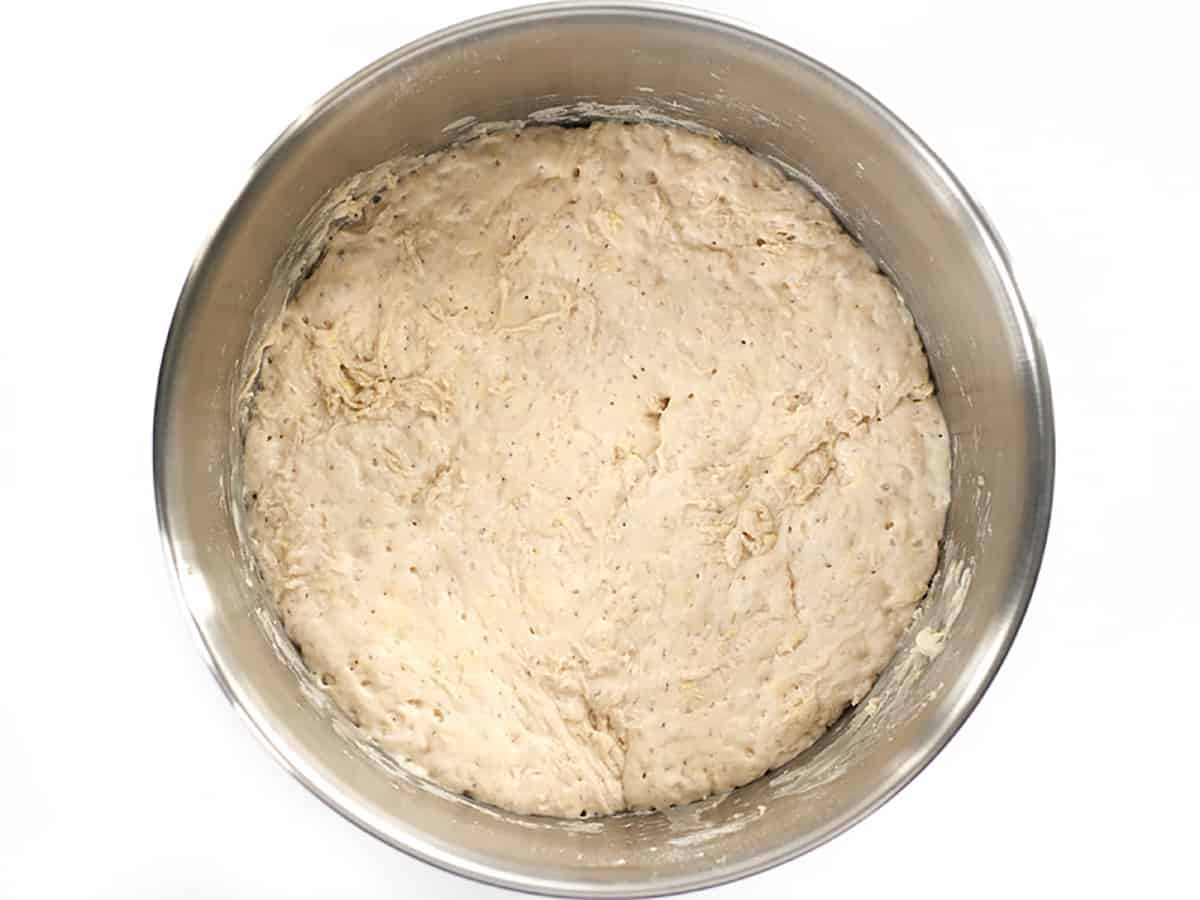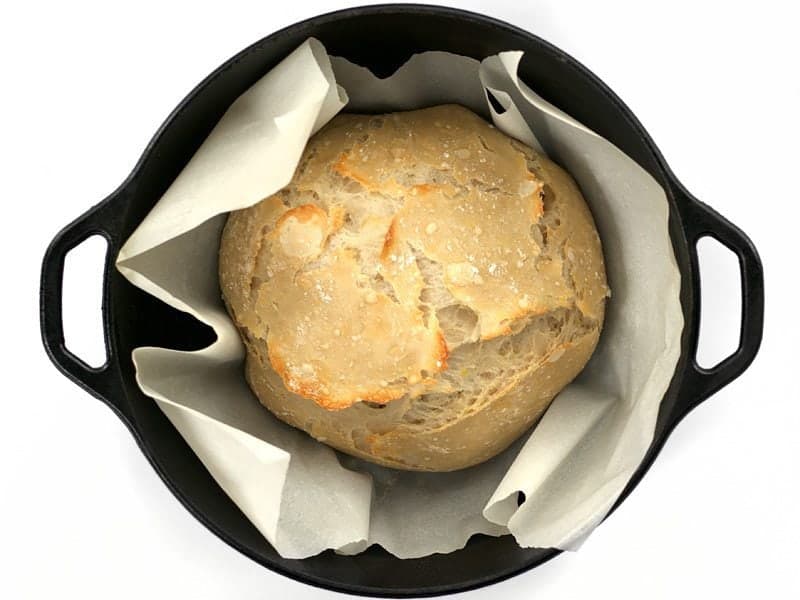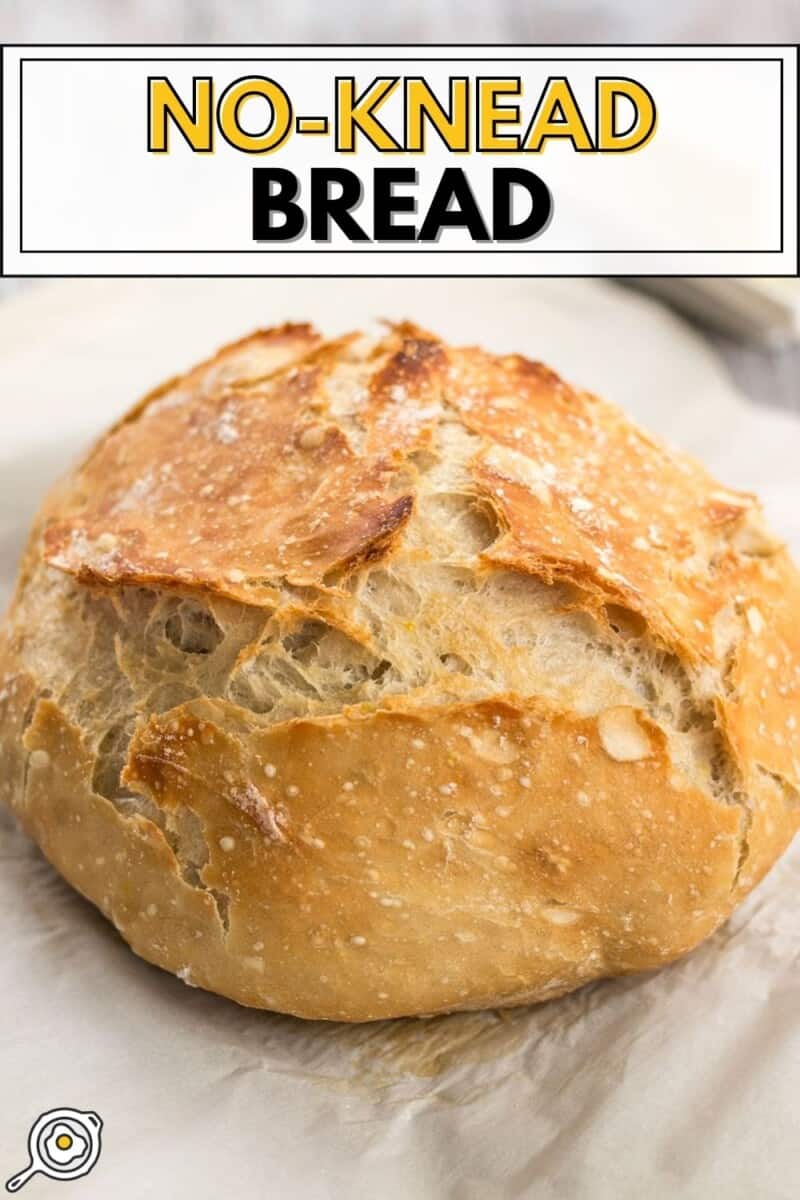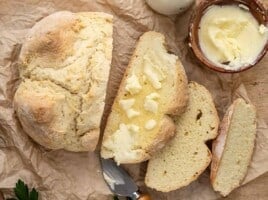I started making no-knead bread in 2010 and it has continued to be my favorite way to make homemade bread because it’s incredibly simple, it doesn’t require a lot of effort, and it makes the most deliciously crusty bakery-style bread ever. To make this no-knead bread recipe you only need four ingredients (including water) and a little bit of time. No fancy equipment or techniques needed!

This post contains some affiliate links, which means that we make a small commission off items you purchase at no additional cost to you.
“I’ve made this twice and it was amazing! Hard to believe something so simple can come together to be something so amazing!”
-Melissa
What Is No Knead Bread?
No-knead bread is an ancient technique for making delicious loaves of bread by utilizing a long fermentation time to develop the gluten the flour instead of hand kneading. Gluten is the protein that gives bread its strength, allowing it to rise into a fluffy loaf, and have that deliciously chewy texture. Kneading bread dough develops gluten quickly, but is quite labor-intensive. If given enough time, yeast can develop the gluten in the dough without the need for manual needing.
Ingredients for No Knead Bread
The best part about this no-knead bread recipe is that it only requires four ingredients, including water, and you still get an incredibly flavorful bread. Here’s all you’ll need to make your own homemade no-knead bread:
- Flour: Our version of no-knead bread was developed using all-purpose flour because that is what we most commonly have on hand. That being said, using bread flour will create even better results. Just keep in mind that bread flour tends to absorb more water than all-purpose flour, so you may need to adjust the ratios slightly.
- Yeast: For this type of bread, we use instant yeast or bread machine yeast, both of which do not need to be activated first by proofing in warm water. You can simply add them to your dry ingredients and go!
- Salt: Without the proper amount of salt, homemade bread will have no flavor, so it’s imperative that you do not skip the salt.
- Water: Water hydrates the flour to create the dough. Because this technique uses a longer ferment time, you can use room-temperature water and you do not have to “wake up” the yeast with warm water. The yeast will have plenty of time to activate as it rests.
What Kind of Yeast to Use
It’s very important to use the correct type of yeast for this recipe. Instant yeast and bread machine yeast are special because they do not require mixing with warm water to “wake up” before adding to a recipe. You can simply stir them into the dry ingredients and they will activate instantly upon hydration, so that is what we use for this super simple no-knead bread technique. Active Dry yeast, on the other hand, needs to be specifically activated in warm water first. If you use active dry yeast in this recipe using the technique below, the bread will likely not rise.
Do I Need to Use a Dutch Oven?
Using a preheated Dutch oven does create the best results because it gives the bread an extra intense boost of heat while retaining all of the moisture and steam. That being said, I have made no-knead bread on a sheet pan with great results! I suggest adding a pan with an inch or so of water on the bottom rack of your oven to create steam if you’re baking your bread on a sheet pan.
If possible, I would suggest investing in a Dutch Oven because they are easily one of the most flexible and useful pieces of cookware. We love our Amazon Basics 6-Quart Enameled Dutch Oven as a very affordable alternative to Le Creuset. Lodge also makes very affordable Enameled Dutch Ovens and plain Cast Iron Dutch Ovens (like the one used in the photos here).
Short Fermentation vs. Long Fermentation
You can make no-knead bread using either a long fermentation (12-18 hours) or a short fermentation (about 2 hours). The difference is that you’ll need more yeast to do the short fermentation and the flavor does not develop quite as deeply. That being said, short fermentation no-knead bread is a great option when you haven’t planned ahead!
Long Fermenation: Follow the instructions below, using ¼ tsp yeast and fermenting the dough for 12-18 hours.
Short Fermentation: Use 2 tsp yeast (or one ¼ oz. packet) and ferment the dough for about 2 hours at room temperature.

No-Knead Bread

Ingredients
- 3 cups all-purpose flour ($0.29)
- 1/4 tsp instant yeast or bread machine yeast* ($0.02)
- 1.5 tsp salt ($0.02)
- 1.5 to 1.75 cup water** ($0.00)
Instructions
- The day before baking, combine the flour, yeast, and salt in a large bowl and stir until they're well combined. Stir in about 1.5 to 1.75 cups room temperature water until a shaggy, sticky ball of dough forms and there is no dry flour left on the bottom of the bowl. The dough should be wet and sticky, but not so wet that it appears glossy. Cover the bowl loosely with plastic and let it sit at room temperature for 12-18 hours.
- The next day, the dough should be fluffy and very bubbly. When you're ready to bake, sprinkle a little flour on top of the fermented dough and scrape it out of the bowl. With well-floured hands, shape the dough into a ball and place it on a piece of parchment paper. Let the dough rise for 30-60 minutes.
- While the dough is rising, preheat the oven to 425ºF, or the highest recommended temperature listed on the packaging for your parchment paper. Place the Dutch oven inside the oven as it preheats, and make sure it sits in the fully heated oven for at least 15 minutes before baking the bread.
- Once the bread has risen and the Dutch oven is fully heated, carefully remove the Dutch oven from the oven (it will be EXTREMELY hot). Lift the parchment with the dough straight into the dutch oven and cover it with the lid.
- Return the Dutch oven to the oven and bake for 30 minutes. Carefully remove the lid and bake for another 15-20 minutes, or until the crust is a deep golden brown. Remove the Dutch oven from the oven, lift the bread out by by using the parchment paper, and allow it to cool before cutting open and serving.
Sheet Pan Instructions
- Ferment and shape the dough as described above, then place it on a parchment-lined sheet pan to rise for an additional 30 minutes.
- Place a baking pan with about an inch of water on the bottom rack of the oven, then preheat to 425ºF while the dough rises.
- Once the loaf has risen for 30 minutes and the oven is fully preheated, carefully score the top of the dough with a sharp knife (use horizontal motions with no downward pressure). Transfer the sheet pan to the oven and bake for 40 minutes, or until the crust is deeply golden brown and the loaf sounds hollow when tapped.
See how we calculate recipe costs here.
Equipment
- Cast Iron Dutch Oven
- Mixing Bowls
- Parchment Paper
- Liquid Measuring Cup
Notes
Nutrition

How to Make No-Knead Bread – Step by Step Photos

Before you begin, make sure you have “instant yeast” or “bread machine yeast” rather than “active dry”. The reason you need this type of yeast specifically is because it does not need to be kick-started by mixing with warm water first. You can add it to a recipe dry and it will still activate. I buy these little jars, which I keep in my fridge, and they last for-ev-er (especially when you’re only using 1/4 tsp at a time)!

The day before you want to actually bake the bread, combine 3 cups all-purpose flour, 1/4 tsp instant or bread machine yeast, and 1/2 Tbsp salt in a large bowl. Stir them together really well.

Stir in about 1.5 to 1.75 cups of room temperature water, or just enough to form a shaggy ball of slightly sticky dough, and no dry flour is left on the bottom of the bowl. The total amount of water needed may vary from time to time depending on the ambient humidity and moisture content of the flour, so go on visuals here. Make sure it comes together in one ball and no dry flour is left on the bottom of the bowl. It’s okay for it to be a bit sticky.

Loosely cover the bowl with plastic and let the dough ferment at room temperature for 12-18 hours. If you need to let it sit longer than that to fit your schedule, just transfer it to the refrigerator. As the dough ferments, it becomes very big, light, fluffy, and bubbly.

Sprinkle a little flour onto the dough (because it will be sticky) and scrape it out of the bowl. It will begin to deflate as you scrape it out.

Using floured hands, shape the dough into a ball, then place it on a large piece of parchment. Let the dough rise for 30-60 minutes. The shorter rise time will produce a slightly more dense bread and the longer rise time will have larger bubbles.

While the dough is rising, begin to preheat the oven and the Dutch oven. Set the oven to 425ºF, or whatever the highest safest temperature is for your brand of parchment (it will usually be listed on the box somewhere). Make sure your Dutch oven is inside the oven as it preheats, and then let it heat for an additional 15 minutes or so once the oven is up to temperature. This makes sure that the Dutch oven is nice and hot.

When the dough is risen and the Dutch oven is fully preheated, carefully remove the Dutch oven from the oven (it will be extremely hot!). Lift the risen dough by the parchment and place it inside the Dutch oven, parchment and all. Place the lid on the Dutch oven and return it to the hot oven.

Let it bake for 30 minutes with the lid on the Dutch Oven, then carefully remove the lid…

Then bake it for an additional 15 minutes or so WITHOUT the lid to allow the crust to brown.

Once the crust achieves a nice deep golden brown color, carefully remove the Dutch Oven from the oven. Lift the no-knead bread out of the Dutch oven by the parchment, and allow it to cool before serving.

And just be prepared for the BEST bread you’ve ever made yourself. ;) The crust on this no-knead bread is seriously amazing.
No Dutch Oven and Short Fermentation Instructions
So, as I mentioned before, you can still bake this bread without a Dutch oven and with a short, 2-hour fermentation time. Here is a photo of my no-knead bread using just 2 hours of fermentation (plus another 1 hr rise time) and baked on a baking sheet.

If you only have about 2-3 hours to ferment the dough, you’ll need to increase the amount of yeast used to 2 tsp (instead of 1/4 tsp).
Let the dough ferment in the bowl for 2 hours, then shape it into a loaf, transfer it to a baking sheet covered with parchment (and sprinkled with cornmeal, if desired) and let rise for about another hour. I like to make slits in the top with a sharp knife after the loaf has risen. Be careful though, if the knife is not sharp enough or you use too much downward pressure, it can deflate the dough.
Brush the surface of the dough with water, then bake it in a preheated oven (again, as hot as the parchment will allow, usually around 425ºF) for 30-40 minutes, or until the crust is nicely browned.







Is there a reason that this recipe doesn’t have sugar or oil / shortening?
This type of bread doesn’t need oil and it’s not a sweet bread to need sugar.
Hello, thanks for this nice recipe. My friend in Brazil doesn’t have any parchment paper. Can she bake it directly in a baking sheet?
Thanks!
Yes that would be okay! She could use foil too.
Just made my first loaf. Followed recipe exactly and it turned out beautifully! Eating it tonight with your zuppe toscana soup. Thanks for the recipe!!
Can this be made with whole wheat flour? Thanks!
I wouldn’t suggest using more than 50% whole wheat flour because at that point it starts to affect the texture and density too much. You may need slightly more water if using some whole wheat flour as well, since whole wheat flour absorbs more than white flour.
Fantastic recipe. I find myself making it once a week. I love to experiment with different flavored salts!
Love this recipe! Can I make it with gluten free flour?
Unfortunately I haven’t tried that, but I do know that the gluten in the flour is critical to creating the texture in this bread, so I’m guessing it wouldn’t work so well.
I’ve tried it many times with gluten-free and regular flour, and I can safely say that it does not work with GF flour – it turns into sort of a big, crusted pancake. I’ve heard that adding xanthan gum helps GF bread to rise, but I haven’t experimented with this myself.
hi- I only have regular yeast and can’t get instant bc covid :( How can I adapt this recipe?
The first time I made no-knead bread, I used active yeast, activated it first in a little bit of warm water, and just used a little less room temperature water. let it rise/sit for 15 hours, or around that. It was great!
when the dough is rising , is is necessary to cover?
You can cover lightly with a kitchen towel.
Just baked my first loaf and it is so delish!! Thank you for this great recipe. My question is about storage after it is all done. What will allow it to last longest and taste best over a few days? Should it be put in a plastic zip lock after completely cooling? Paper bag? Refrigerated? Frozen?
Definitely wait until it has completely cooled to room temperature before wrapping it anything because otherwise you’ll get condensation. I like mine kept in a zip top bag at room temperature, best. The crust won’t stay crusty that way, but it does prevent it from drying out. If you do paper or a waxed cloth wrap the crust will stay nice, but the inside will dry out sooner, so it’s kind of a give and take. :)
I love the bread. It is so easy. and makes one nice sized loaf for us singles…..I have been making bread for my neighbours during Covid 19 lockdown… Gives me something to do and keeps neighbours happy.
I must be doing something wrong here, but I can’t figure out what it is. Whenever I try this recipe (or other no-knead recipes for that matter, like the Mark Bittman one) the dough is very, very wet – more like a quickbread batter than dough. I measured the flour using the King Arthur flour “fluff, sprinkle and scrape” method and double-checking with a scale (12.7 oz for three cups). I’m using saf-instant yeast, iodized salt, tap water, and all purpose flour (it is some fancy unbleached stone-ground all purpose flour because that’s all that was left at the store) and mixing it up in a bowl with a rubber spatula. Anyone have any ideas about where I’m going wrong here?
The dough should be very wet. :) You want it to almost be kind of sticky, but not so wet that it’s glossy. If it is glossy wet, simply add a little more flour.
I have had the same problem as CONFUSED. I used three cups flour and only 1 1/4 cups water. My room temperature has been about 68 F and I let it rise the full 24 hours. There was no way my blob of dough could ever be shaped into a ball. Do you think I should try a shorter rise time?
The dough will be very stick and loose after the fermentation. Just sprinkle it with a little flour and fold it onto itself until it is a more round “blob” haha. It’s not the same as traditional bread dough. :)
Hi, the first time I tried I followed the amount of water listed in the recipe and I got the same problem as you. The consistency of a cake batter. The next time I tried, I started putting 1/4 cups at a time until I reach the same consistency as the photo representation here, so I found out the perfect amount for me was 1 and 1/4 cup of water. less than the amount listed. Humidity in the air and in the flour will vary so start putting smaller quantities until you reach the photo and you will have the correct amount for your situation. It’s still sticky but it holds it shape.
Hi there, I only have a 2 3/4 quart cast iron, should I half the recipe or amount of dough I put in it?
Yes you could make two loaves that way.
Love this recipe but we always eat it too quickly! Was wanting to perhaps double the recipe but I am unsure how that would change the fermentation and cooking times, any tips?
Yes, you should be able to double the size, although it may need longer to bake.
Thank you for the great recipe.
When adding the costs up for each ingredient of the recipe, don’t forget additional components like the electricity/gas cost required to heat an oven to over 400 degrees, as well as the labor costs involved. Using “activity-based costing” would show the recipe to be more expensive, ultimately.
Should my oven rack be at a high or low level? Thank you. Trudy
Lower to middle is best.